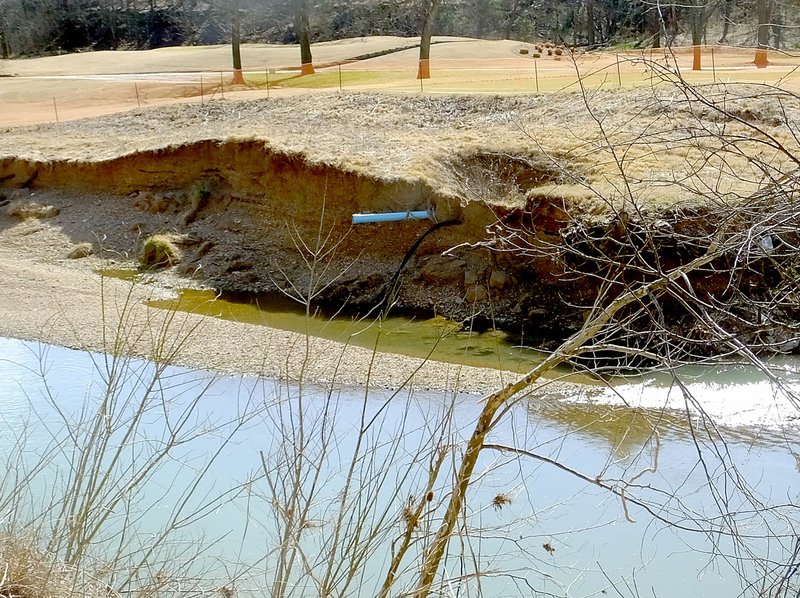On April 27, 2017, rainwater overwhelmed Little Sugar Creek and rushed towards three Bella Vista Golf courses, carrying gravel, rocks, and tree limbs and leaving behind severely eroded creek banks. All three of the "valley" courses -- the creek runs through each one -- were damaged, and one course -- Berksdale -- never reopened fully.
At the next board work session, general manager Tom Judson told the board that it would take at least $500,000 in repairs to reopen Berksdale. Since that was the third major flood in six years, it was time to consider a hydrology study before investing more money into the course.
Later in the summer, nine holes at Berksdale were reopened, but the other nine holes have remained closed. In June, a task force was announced with the goal of hiring an engineering firm to take on the hydrology study.
Members got their first look at the study last week, and more than 300 of them came to the first open meeting to hear Judson and members of the task force discuss it. The study and Judson's PowerPoint presentation about it are available on the POA website, bellavistapoa.com/valley-flood-study/, along with minutes from all the task force meetings.
The golf courses have always been in a floodplain, Judson pointed out. That was a conscious decision when Cooper Communities was developing the land. Since they couldn't build homes there, they built a golf course. That means the POA has to deal with the fact that the land will always flood.
In recent years, the floods have gotten worse because of the developments in Bentonville and Centerton. Land that used to absorb rainwater, is now covered with buildings and asphalt and the rainwater is directed into Little Sugar Creek.
The watershed that flows into Lake Bella Vista via Little Sugar Creek is 85.8 square miles.
Judson assured the audience that all of their suggested remedies had been researched. For example, many people believe that dredging Lake Bella Vista and possibly raising the height of the dam can solve the flooding problem, he said.
There are a couple problems with that plan, he said. First, neither the POA or the city of Bella Vista own Lake Bella Vista. It's part of Bentonville. But if permission to do the work could be obtained, it wouldn't be enough, he said.
"With regards to flood retention, Lake Bella Vista has been described as a 'puddle,'" Judson said. Also, he said, raising the height of the dam might send the flood waters across Highway 71, something the state would not allow.
The POA does own several lakes of its own and the study looked at using them for stormwater retention. Unfortunately, they meet Little Sugar Creek downstream from where much of the damage occurs. In fact, Loch Lomond, the largest of the POA lakes feeds into the Gordon Hollow watershed, which connects with Little Sugar Creek in Missouri.
Even if the POA lakes were completely empty, they could store only a fraction of the water that flows during floods. It takes days to drain the lakes, Judson said, and the people who live around them would not be happy.
Another suggestion was to force Bentonville and Centerton to solve the problem by filing a lawsuit. Judson said that a lawsuit would be expensive and probably not effective. After all, the golf courses were built in a floodplain, so the risk was there from the very beginning.
The engineers also considered dredging the creek, building concrete gates on the streambed and installing French drains to move excess water into the aquifer.
The only solution the engineers found practical was to reinforce the stream banks with various methods that involve rocks.
There are seven areas where the engineers recommend riprap. Riprap has been used along the creek already. In this case, the riprap would be made up of loose rocks in excess of 90 pounds. The cost was estimated at $1,163,000.
Some areas may be stabilized with longitudinal peaked stone toe protection, which is a line of rock at the toe or bottom of a slope. Willows are typically planted behind the rock. The project would make up 6,500 linear feet.
The worst areas would need a gabion wall which is made up of rocks enclosed in wire baskets. An estimated 500 feet of stream bank needs that most expensive solution.
The recommended stream bank stabilization would cost about $1,725,000 and would take up to two years.
Another part of the problem is the golf cart bridges that have been damaged by the floods. There are five bridges that will need to be replaced within about five years, Judson said. The bridges will cost $2,040,000.
Although people suggest the POA could build bridges that only support the weight of a golf cart, that's not practical, Judson said. Some bridges need to support the weight of emergency vehicles that could be needed if a golfer became ill, and all of them are used by heavy equipment needed for golf course maintenance.
The two recommended projects total $3,765,000, Judson said, and that doesn't include other work that will probably be necessary, including raising some greens and tee boxes.
Early in the presentation, Judson and board chairman Ron Stratton said there would be no decisions made immediately. The flood study needs to be carefully reviewed before decisions can be made. Another meeting to look at options has been scheduled for 4 p.m. on April 10.
During the open forum, one resident complained that the board held the study for two weeks before letting members see it.
Another resident pointed out that lining the banks with rock will detract from the beauty of Little Sugar Creek and wondered if the POA had considered a natural channel design.
Judson said he met with the Army Corps of Engineers and every agency he thought might be helpful, but he didn't find any funding for the project other than POA money.
General News on 03/21/2018

